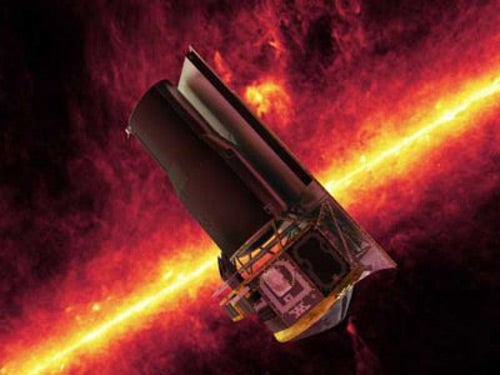NASA’s Spitzer Space Telescope has discovered something odd about a distant planet — it lacks methane, an ingredient common to many of the planets in our solar system.
“It’s a big puzzle,” said Kevin Stevenson, a planetary sciences student at the University of Central Florida in Orlando. “Models tell us that the carbon in this planet should be in the form of methane. Theorists are going to be quite busy trying to figure this one out.”
The discovery brings astronomers one step closer to probing the atmospheres of distant planets the size of Earth. The methane-free planet, called GJ 436b, is about the size of Neptune, making it the smallest distant planet that any telescope has successfully analyzed. Eventually, a larger space telescope could use the same kind of technique to search smaller, earthlike worlds for methane and other chemical signs of life, such as water, oxygen, and carbon dioxide.
“Ultimately, we want to find biosignatures on a small, rocky world. Oxygen, especially with even a little methane, would tell us that we humans might not be alone,” said Stevenson.
“In this case, we expected to find methane not because of the presence of life, but because of the planet’s chemistry,” said Joseph Harrington of the University of Central Florida. “This type of planet should have cooked up methane. It’s like dipping bread into beaten eggs, frying it, and getting oatmeal in the end.”
Methane is present on our life-bearing planet, manufactured primarily by microbes living in cows and soaking in waterlogged rice fields. All of the giant planets in our solar system have methane, too, despite their lack of cows. Neptune is blue because of this chemical, which absorbs red light. Methane is a common ingredient of relatively cool bodies, including “failed” stars, which are called brown dwarfs.
In fact, any world with the common atmospheric mixes of hydrogen, carbon, and oxygen and a temperature up to 1340° Fahrenheit (730° Celsius) is expected to have a large amount of methane and a small amount of carbon monoxide. The carbon should “prefer” to be in the form of methane at these temperatures.
At 980° F (530° C), GJ 436b is supposed to have abundant methane and little carbon monoxide. Spitzer observations have shown the opposite. The space telescope has captured the planet’s light in six infrared wavelengths, showing evidence for carbon monoxide but not methane.
“We’re scratching our heads,” said Harrington. “But what this does tell us is that there is room for improvement in our models. Now we have actual data on faraway planets that will teach us what’s really going on in their atmospheres.”
GJ 436b is located 33 light-years away in the constellation Leo the Lion. It rides in a tight 2.64-day orbit around its small star, an “M-dwarf,” which is much cooler than our Sun. The planet transits, or crosses in front of, its star as viewed from Earth.
Spitzer was able to detect the faint glow of GJ 436b by watching it slip behind its star, an event called a secondary eclipse. As the planet disappears, the total light observed from the star system drops — this drop is then measured to find the brightness of the planet at various wavelengths. The technique, first pioneered by Spitzer in 2005, has since been used to measure atmospheric components of several Jupiter-sized exoplanets, the so-called “hot Jupiters,” and now the Neptune-sized GJ 436b.
“The Spitzer technique is being pushed to smaller, cooler planets more like our Earth than the previously studied hot Jupiters,” said Charles Beichman, director of NASA’s Exoplanet Science Institute at NASA’s Jet Propulsion Laboratory and the California Institute of Technology, both in Pasadena, California. “In coming years, we can expect that a space telescope could characterize the atmosphere of a rocky planet a few times the size of Earth. Such a planet might show signposts of life.”










